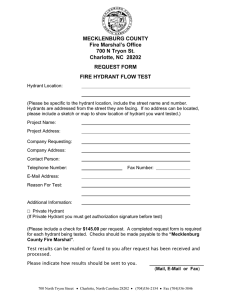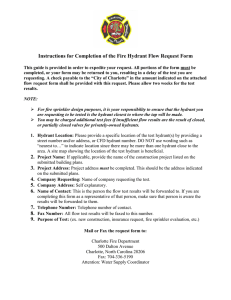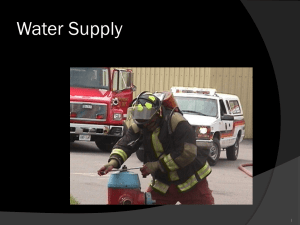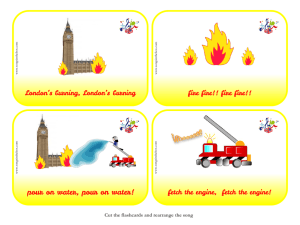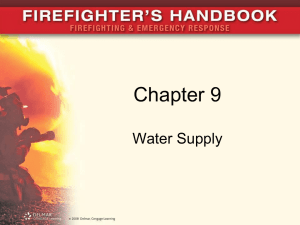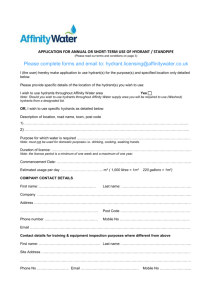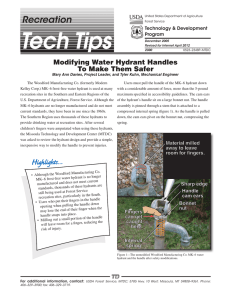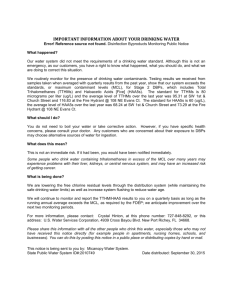FIRE HYDRANT (PRIVATE) TESTING PROCEDURE Fire Safety Technical Guide
advertisement
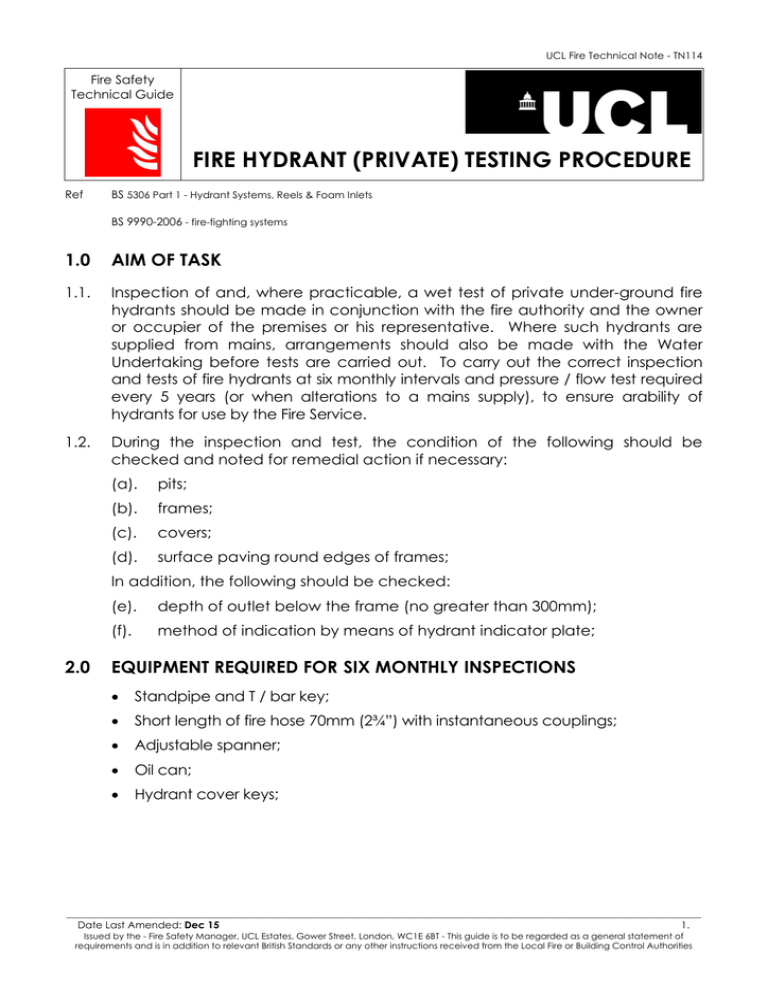
UCL Fire Technical Note - TN114 Fire Safety Technical Guide FIRE HYDRANT (PRIVATE) TESTING PROCEDURE Ref BS 5306 Part 1 - Hydrant Systems, Reels & Foam Inlets BS 9990-2006 - fire-fighting systems 1.0 AIM OF TASK 1.1. Inspection of and, where practicable, a wet test of private under-ground fire hydrants should be made in conjunction with the fire authority and the owner or occupier of the premises or his representative. Where such hydrants are supplied from mains, arrangements should also be made with the Water Undertaking before tests are carried out. To carry out the correct inspection and tests of fire hydrants at six monthly intervals and pressure / flow test required every 5 years (or when alterations to a mains supply), to ensure arability of hydrants for use by the Fire Service. 1.2. During the inspection and test, the condition of the following should be checked and noted for remedial action if necessary: (a). pits; (b). frames; (c). covers; (d). surface paving round edges of frames; In addition, the following should be checked: 2.0 (e). depth of outlet below the frame (no greater than 300mm); (f). method of indication by means of hydrant indicator plate; EQUIPMENT REQUIRED FOR SIX MONTHLY INSPECTIONS Standpipe and T / bar key; Short length of fire hose 70mm (2¾”) with instantaneous couplings; Adjustable spanner; Oil can; Hydrant cover keys; ___________________________________________________________________________________________________________________________ Date Last Amended: Dec 15 1. Issued by the - Fire Safety Manager, UCL Estates, Gower Street, London, WC1E 6BT - This guide is to be regarded as a general statement of requirements and is in addition to relevant British Standards or any other instructions received from the Local Fire or Building Control Authorities UCL Fire Technical Note - TN114 3.0. SAFETY GUIDELINES FOR COMPLETION OF TASK: Caution must be used when lifting heavy hydrant cover plates; Production of water from hydrants must not be carried out when water is likely to freeze causing a slip hazard; Other Safety measures that may be need depending on circumstances: o Ensure ‘Danger’ road sign is placed on the road to face oncoming traffic; o All personnel are to wear a fluorescent surcoat when inspecting or testing hydrants; 4.0. Charging the Hydrant 4.1. With the standpipe fitted to the outlet, a short length of 70mm (2¾”) delivery hose should be connected to the standpipe and run out clear of the hydrant pit towards a drain. The hydrant valve should be opened slowly and fully. If it appears that the pressure and or flow is particularly poor, an entry to this effect should be noted. 5.0. Frost Valve Operative 5.1. The frost valve (where fitted) should be checked to ensure that it is in satisfactory working order. Record any deficiency on the hydrant quick reference sheet. 6.0. On Completion of Task 6.1. After each inspection or test, ensure that the hydrant pit is left empty and clean and that the hydrant cover plate is refitted securely over pit. 7.0. Hydrant Maintenance Inspection Guide Sheet 7.1. Use the inspection guidance & record sheet of six monthly inspection and testing if the fire hydrant & pits at Annex A below. Note: Standard operational fire hose generally comes as: 70mm (2¾”) x 25m; 45mm (1¾”) x 25m; ___________________________________________________________________________________________________________________________ Date Last Amended: Dec 15 2. Issued by the - Fire Safety Manager, UCL Estates, Gower Street, London, WC1E 6BT - This guide is to be regarded as a general statement of requirements and is in addition to relevant British Standards or any other instructions received from the Local Fire or Building Control Authorities UCL Fire Technical Note - TN114 ANNEX A Hydrant No & Location: ______________________________ Date: _______ PHYSICAL CHECK OF THE HYDRANT PIT & COVER: The Hydrant Pit: Yes: 1 Is the surrounding surface paving sound? 2 Is the cover free from vegetation and or debris? 3 Is the cover and frame sound? 4 Is the cover painted Canary Yellow (BS 381C No: 309 Canary Yellow)? 5 Does the cover need repainting? 6 Is the underside of cover marked with the direction of opening? 7 Is the pit structurally sound? 8 Is the pit dry? 9 Is the pit free draining? 10 Is the pit in waterlogged ground? No: The Hydrant Valve: 11 Is the hydrant is screw down / sluice valve or pillar type? 12 Is the valve packing sound? 13 Is the outlet is fitted with a cap 14 Is the cap secured to hydrant 15 Does the outlet have a round thread? 16 Does the standpipe screw correctly onto outlets threads? 17 Is the outlet 300mm or less from the top of the pit? 18 If not what is the distance to the outlet? 19 Is a frost valve is fitted? 20 Does it appear to be in working order 21 Is a false spindle fitted? 21a Is it properly secured? 21b Is there a securing bolt? 21c Is the bolt well oiled? Markings: 100 5 Plates should be a not less than 180 mm wide by 205 mm high Hydrant marker post and indicator plate are in position and correct for main size, distance and hydrant identification number is marked on post. Top number indicates the size in mm of the water main feeding the fire hydrant (100 mm) The lower number indicates in metres the distance from hydrant pate the hydrants cover is away (i.e. 20 m) The hydrant lid / frame shall be identified by being painted to conform to Colour Reference No: 309 (Canary Yellow), BS 381C. ___________________________________________________________________________________________________________________________ Date Last Amended: Dec 15 3. Issued by the - Fire Safety Manager, UCL Estates, Gower Street, London, WC1E 6BT - This guide is to be regarded as a general statement of requirements and is in addition to relevant British Standards or any other instructions received from the Local Fire or Building Control Authorities
